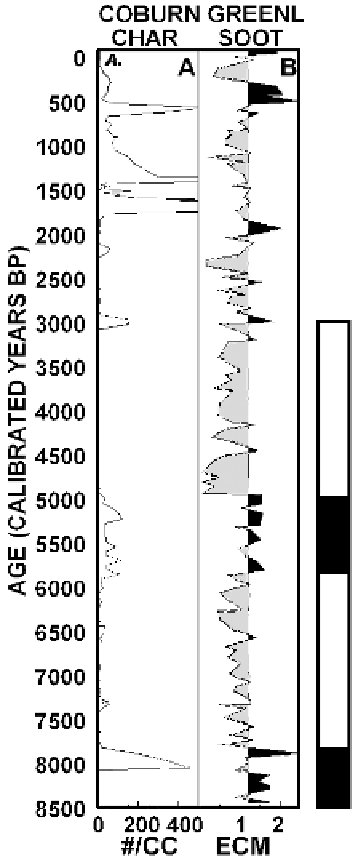Geoscience Reference
In-Depth Information
in central Greenland at the 90% and 95% con
dence limits,
respectively. Statistical values were calculated separately for
both the mean precipitation within each 200 year window and
for the magnitude of variance in precipitation within each 200
year window (Figure 8).
The results of the logistics regression model suggest that
the largest charcoal peaks from Coburn Lake were deposited
during or close to peak drought conditions in the North
Atlantic region. The seven largest charcoal peaks from Co-
burn Lake were signi
were beginning in the western United States [En
eld et al.,
2001; Schubert et al., 2004].
This bidirectional synchronicity suggests a hypothesis that
large-scale shifts in the locations of the Earth
s major precip-
itation belts may have occurred during periods of ACC in the
'
cance
levels with peak drought conditions in central Greenland in
terms of both their mean values of precipitation within each
200 year window and the magnitude of change in precipita-
tion within each 200 year window.
A closer examination of just the past 1800 years reinforces
the idea that charcoal deposition at Coburn Lake was often
synchronous with ending of severe drought conditions in the
North Atlantic region, particularly during the late Holocene
(Figure 9) [Wathen, 2011]. The beginnings of severe
droughts and the occurrence of severe fires at Coburn Lake
in the Sierra Nevada were signi
cantly correlated at 90% signi
cantly correlated with the
beginning of drought conditions in Greenland (Pearson prod-
uct moment correlation coefficient, r = 0.998) [Meese et al.,
1994; NSIDC and WDC-A, 1997]. One of the eight charcoal
peaks, however, occurred approximately 100 years before
the onset of a severe drought, during a time of peak precip-
itation instead of peak drought conditions in Greenland.
A comparison between the timings of the beginning of
severe droughts in the northern Sierra Nevada and a paleo-
temperature record from Greenland suggests another inter-
esting relationship. The Pyramid Lake drought record was
visually compared with a temperature record from Greenland
[Johnsen et al., 1995; NSIDC and WDC-A, 1997] (Figure 5).
Prior to 5200 years ago, the beginnings of droughts in the
northern Sierra Nevada were generally associated with the
beginnings of droughts in Greenland but not necessarily with
high temperatures in Greenland. However, after 5200 years
ago, with one exception, the beginnings of droughts in the
northern Sierra Nevada were associated with both increasing
precipitation as well as increasing temperatures in Greenland.
Warming in Greenland at the beginnings of severe
droughts in the northern Sierra Nevada after the 5200 year
ACCE agrees with the
Figure 10.
Correlation between the timing of charcoal deposition
into Coburn Lake, California, and soot deposition onto central
Greenland glaciers over the past 8500 years. (a) Abundance of
charcoal particles (>250
finding (section 5.1.2, above) that the
beginnings of severe droughts in the northern Sierra Nevada
were associated with high temperatures in the Sierra Nevada
over the past 1800 years [Wathen, 2011] (Figure 7).
Taken together, these findings suggest that temperatures
and precipitation were rising in Greenland as severe droughts
were beginning in the northern Sierra Nevada. These
m in size) per cm
3
of Coburn Lake
sediment. (b) Peaks in soot accumulation, based on electrical con-
ductivity, from the GISP2 Greenland ice core. Data are from the
work of Taylor et al. [1996]. The change in shading in Figure 10b
denotes the median value. In the vertical box to the right, black
shading highlights time periods when Figures 10a and 10b appear to
have shared a similar pattern of deposition.
μ
findings
agree with other studies that have found that the northern
Atlantic Ocean was warm when severe drought conditions










Search WWH ::

Custom Search